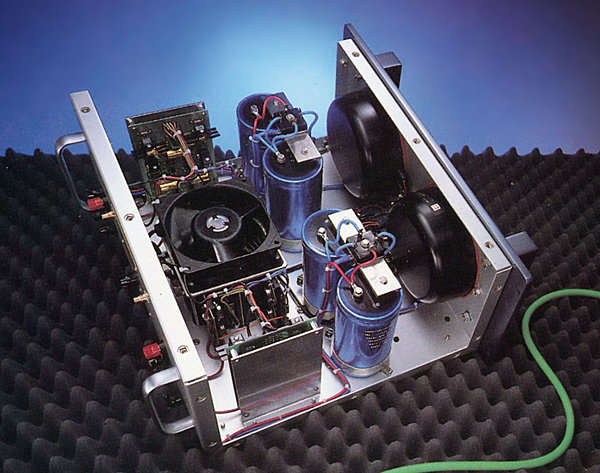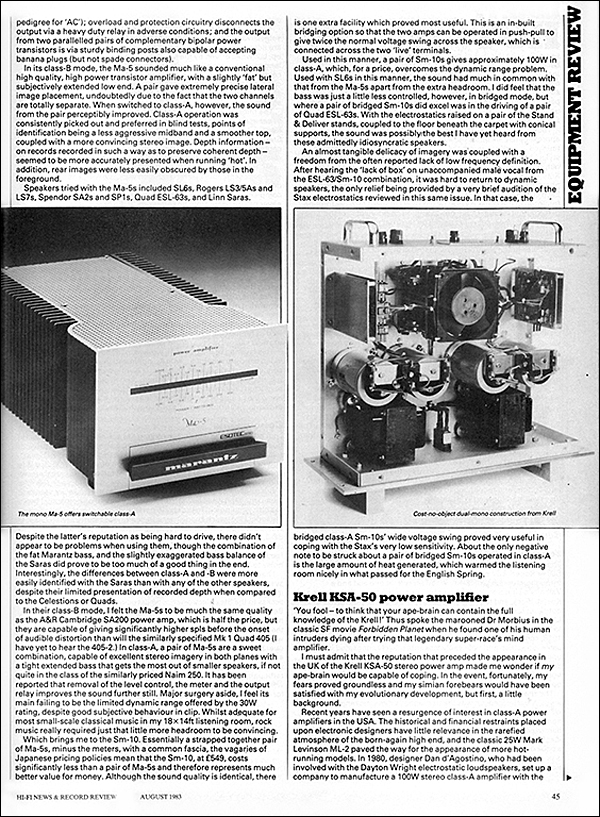Some Like It Hot Page 2
Krell KSA-50
In recent years there has been a resurgence of interest in Class A power amplifiers in the USA. In 1980, designer Dan d'Agostino, who had been involved with the Dayton Wright electrostatic loudspeakers, set up a company to manufacture a 100W stereo Class A amp with the emphasis on high quality, both of sound and of construction. In fact, Dan has a reputation for never using an inexpensive component if a better but more expensive one would serve. Despite this lack of commercial realpolitik – or perhaps because of it – the Krell amps sold and the range rapidly expanded to include 200W mono and 50W stereo power amps, both still Class A, and a dual mono preamp.
Absolute Sounds started to import the Krell power amps into the UK early this year and, being of a parsimonious nature, I asked if I could review the least expensive £1250, 50W KSA-50. It's large and heavy – 63lb – for a 50W amp, approximately six times the size of the Quad 405 and is immaculately finished in dark grey, with the gold-plated chassis screws made a styling feature. Signal input is via a pair of gold-plated phonos and output via heavy-duty binding posts. And that about wraps up the amp's external features.
Internally, each channel is completely separate, from the transformers (the very latest version of the amplifier uses big Avel Lindberg toroids) through to the output terminals, the only common components being the contact-breaker-type mains switch on the front panel and the (almost) silent fan. At the core of each channel's power supply are a pair of 40,000µF computer-grade electrolytics, with the earth point between them formed by a plated solid-copper bus-bar bolted to the terminals, which also serves as a heatsink for the bridge rectifier.

Class A All The Way
Behind the supply caps are the two fully complementary amp boards, with military-spec components being used throughout. Overall negative feedback is a low 15dB, and the four pairs of output devices, two in parallel for each channel, are mounted on a forced-air heatsink arrangement, the slow-running fan drawing air past the power supply and exhausting through the base.
And that's it: apart from rail fuses for each channel, series speaker fuses, and thermal shutdown in case of overload, there is no active protection circuitry. There isn't even an output choke, commonly found in nearly all power amps to define the EHF bandwidth and thus prevent instability with highly capacitive loads, confident enough is Dan d'Agostino in the well-behaved nature of his amplifier.
In its literature Krell makes great play of the fact that, whereas nearly all Class A amps actually degenerate to Class A/B before reaching their rated output, the Krell amps stay in Class A all the way. I measured the KSA-50 as having a standing current of around 1.8A, which means it will deliver 50W into an 8ohm load without turning off output devices.
The specification is not pretentious regarding distortion – better than 0.1% THD and 0.1% IMD – but is impressive regarding power output. The design intention was to make the KSA-50 as near a voltage source as possible, the 50W 8ohm output doubling to 100W into 4ohm, and redoubling to 200W into 2ohm. (Below 1ohm, fuses will start blowing.) Considering the paper presented to the Audio Engineering Society in March by Matti Otala et al, showing that the dynamic impedance of real loudspeakers can be as little as 20% of a static 8ohm, this would be expected to have a beneficial subjective effect. So, what exactly did the Krell sound like?
![]() Sound Quality
Sound Quality
The basic system used with the Krell amp comprised either Celestion SL6 or Rogers LS7 speakers, on Celestion stands coupled to the floor through the carpet with ¾in wood screws, at one end and a Valhalla'd Linn Sondek/lttok combination at the other. Pick-up was a Koetsu Black, and to bring the effective mass of the Ittok nearer to optimum for the Koetsu, I followed the advice of Kevin Maxfield (Jefferies Hi-Fi, Eastbourne) and super-glued an additional mass ring to the rear of the tonearm's counterweight.
My choice of preamp, meanwhile, was initially a Meridian 101B, but this was soon replaced by an Audio Research SP-7 as the Meridian was dominating the sound quality.
The character of the Krell sound fell into three readily identifiable areas. Most immediate was the tremendous dynamic range. If this was a 50W amp, then it seemed to have a good 6dB edge over nominal 100W Class B designs before the sound unacceptably hardened. At low levels, too, musical strands could still be readily identified.
Tonally, the balance was light, almost ethereal, with a wide subjective bandwidth and excellent low frequency extension. Celestion SL6s are not speakers a bass guitar aficionado would automatically hook up, but when driven by the Krell amp, they did seem to go down an awful long way. In comparison with the Naim 250, which is its natural UK competition, the KSA-50 was described as having a more civilised and cooler sound, analogous to the difference between hot swing of the '40s and the cerebral bebop which replaced it. I can only agree.
The midrange was different to nearly all transistor amps I've used in being reminiscent of a valve design in its clarity. I have recently been trying a Van Alstine modified Dyna Stereo 70, and although the tube amp had poorly extended/ controlled bass and rolled-off top when compared to the KSA-50, the Class A amp's sweet midband was very similar to that of the Stereo 70.

Window Box
However, the most important characteristic of the KSA-50 was its stereo presentation. Lateral definition was, as expected from a dual-mono design, as sharp as the edge of a new scalpel blade, but complementing this was a delicacy of depth discrimination I had never before heard from box speakers. If the object of stereo is to open a window into another acoustic, then the Krell power amp allowed moving-coil speakers to open up the end of my listening room as though they were electrostatic designs.
The beginning of Andreas Vollenweider's electronic harp LP [American CBS FM37793] consists of naturally recorded woodland birdsong. With the Krell amp, I was in the wood, with a pheasant squawking some 20m ahead of me. The crapgame in the Decca Porgy & Bess sounded as though the dice were actually rolling across the floor of a large bare room adjoining mine, and at the end of Act One of the Colin Davis Tosca – my favourite despite the somewhat matronly Caballe in the title role – the wall behind the speakers disappeared.
Here the effect was to put me in the church almost close enough to smell the wax on Scarpia's moustache as he twizzled the ends. And as for the cannon from the castle of Sant' Angelo, they were in the next village!
This layering of images even worked in mono. The 1932 Elgar violin concerto recording, with Menuhin and the composer conducting the LSO, was revealed as having more depth than the recent DG digital from Itzhak Perlman. And to play the sadly neglected Checkmates' version of 'Proud Mary' was to discover anew the way Phil Spector had captured, in mono, the atmosphere and acoustic of a large hall revivalist meeting.

Conclusion
The KSA-50 is the best power amp I have tried in my system. Its clarity, depth and sheer neutrality, coupled with apparently effortless dynamics, got the best out of all the speakers with which it was used. But a power amplifier, no matter how good, does not make a system alone and the KSA-50 was simply too good at revealing inadequacies in the ancillary equipment to hand. Perhaps an Audio Research SP-10 preamp, at £3500, would do it justice, and Krell itself has a no-holds-barred preamp on the way.
But if you do have pockets deep enough to think about a £1250 power amp, then they will have to be deep enough to cope with the fact that the rest of your system may well have to be rethought. Yet if you're that discriminating... and the KSA-50 did warm up my listening room nicely in the early part of what passed for an English summer!
























































